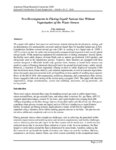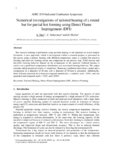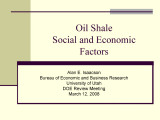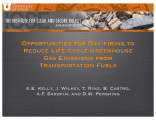TO
Filters: Collection: "ir_eua"
| Title | Date | Subject | Description | ||
|---|---|---|---|---|---|
| 1701 |
 |
Mineralogy of oil shale in the upper part of Parachute Creek member of the Green River Formation in the Eastern Uinta Basin, Utah | 1976 | Parachute Creek; Green River Formation; Uinta Basin; Utah; X-ray diffraction; Oil shale; Curly bed; Wavy bed tuffs; Mahogany zone; Naval Oil Shale Reserve No. 2; Federal Prototype Oil Shale Leas Tract Ua; Smectite; Mineralogy | The relative abundance and distribution of major and minor minerals have been determined by X-ray diffraction for samples of Green River Formation oil shale in three drill cores from the eastern part of the Uinta Basin, Utah. The samples in each core are from the same rock stratigraphic interval bet... |
| 1702 |
 |
Mineralogy of Sunnyside, Utah tar sand deposits | 1981-04-09 | X-ray diffraction; Mineralogy; Sunnyside, Utah; Tar sand deposits | Mineralogy as determined by x-ray diffraction is reported in the attached tables. |
| 1703 |
 |
Minimum slugging velocity in fluidized beds containing vertical rods | 1993-05 | slugging velocity; fluidized beds; vertical rods; PSDF; slugging | A new method for determining the onset of slugging in fluidized beds is presented. Pressuredrop fluctuations, measured from below the distributor to the gas exit line, are transformed to the frequency domain by the power spectral density function (PSDF). The dominant frequency of the PSDF correspond... |
| 1704 |
 |
Model codes and analysis tools for quality growth | The following ordinance is designed as an OVERLAY zone for sensitive areas. It depends on a map, adopted as a zoning overlay map, that identifies the approximate areas where the sensitive lands will be located. The areas are described in this workbook. For the methods and sources of data that may be... | ||
| 1705 |
 |
Model-based design and full-scale demonstration of an oxy-coal firing system with undiluted oxygen and minimal flue gas recycle | The future use of coal as a fuel for industrial applications depends on economical technologies being made available to capture and store the CO2 emitted as a product of the combustion process. One such technology is oxy-combustion, which involves burning of the fuel using pure oxygen as the oxidant... | ||
| 1706 |
 |
Modeling and experimental studies of mercury oxidation and adsorption in a fixed-bed and entrained-flow reactor | 2009-10 | mercury oxidation; mercury absorption; fixed-bed reactor; entrained-flow reactor | This report presents experimental and modeling mercury oxidation and adsorption data. Fixed-bed and single-particle models of mercury adsorption were developed. The experimental data were obtained with two reactors: a 300- W, methane-fired, tubular, quartz-lined reactor for studying homogeneous oxid... |
| 1707 |
 |
Modeling in situ extraction of heavy oil deposits | 2008-03-12 | in situ extraction; heavy oil deposits; in-situ conversion; Shell | A presentation given at the D.O.E. Project Review Meeting, on March 12, 2008 in Salt Lake City, Utah. |
| 1708 |
 |
Modeling of asphaltenes: Assessment of sensitivity of 13C SSNMR to molecular structure | 2012 | asphaltenes; heavy oil; liquid hydrocarbon fuels; 13C SSNMR; molecular structure; refinery process | Asphaltenes are an important constituent of many oils and one of the major components in heavy oils sources for liquid hydrocarbon fuels. With light oil sources rapidly depleting, it is necessary to use alternative sources from heavy oil reservoirs. Refining these heavy oil resources presents new ch... |
| 1709 |
 |
Modeling requirements in government decision making processes: a concept paper | 1976-01 | Over the past several years, several significant advances in the theory and practice of governmental contingency planning and decision making and in required economic modeling support systems have been developed in the Office of the Utah State Planning Coordinator. | |
| 1710 |
 |
Modeling study of carbonate decomposition in LLNL's 4TU pilot oil shale retort | 1994-10-14 | 4 tonne-per-day oil shale Pilot Retort; 4TU-Pilot; Carbonate decomposition; Lawrence Livermore National Laboratory; LLNL | Lawrence Livermore National Laboratory's (LLNL) 4 tonne-per-day oil shale Pilot Retort (4TU-Pilot) has been modeled to study the degree of carbonate decomposition occurring in the process. The modeling uses a simplified version of the processes occurring in the retort to allow parametric studies to ... |
| 1711 |
 |
Modeling sulfur-Nitrogen chemistry indside a claus reaction furnace | This paper describes a CFD analysis of a Sulfur Recovery Unit (SRU) considering transient turbulent reacting flow inside the SRU. Often, the SRU feedstock includes hydrocarbons together with nitrogen and sulfur species, which react with oxygen in the air to form various emissions including SO2, NH3 ... | ||
| 1712 |
 |
Modeling the rich combustion of aliphatic hydrocarbons | 2000 | rich combustion; aliphatic hydrocarbons; kinetic mechanism; benzene formation; high-molecular-mass aromatic compounds | A new kinetic mechanism has been developed for the formation of benzene and high-molecular-mass aromatic compounds in rich flames of aliphatic hydrocarbons. The kinetic scheme emphasizes both the role of resonantly stabilized radicals in the growth of aromatics and the standard acetylene addition me... |
| 1713 |
 |
Modeling the vaporization of ash constituents in a coal-fired boiler | 2000 | vaporization of ash constituents; coal-fired boiler; minimizing harmful emissions; vaporization | Emissions of fine particulate and trace toxic metals are being subjected to increasing regulation. This paper addresses how the emission of these compounds can be influenced by changes in combustion conditions, particularly those selected to minimize NOx emissions. The vaporization and condensation ... |
| 1714 |
 |
Monitoring surfactant content to control hot water process for tar sand | 1991-04-23 | Patent; Hot water process; Tar sand; Extraction; Surfactants | The present invention is based on the following: (1) that when tar sand is conditioned and diluted in the hot water extraction process, there are two classes of anionic surfactants (originating from carboxylate and sulfonate groups) present in the process water; (2) that each of these surfactants ha... |
| 1715 |
 |
Mono Power Company: Sunnyside tar sands project--1983 geologic evaluation | 1984-03 | Mono Power; Sunnyside, Utah; Range Creek; Bruin Point; Whitmore Canyon; Uinta Basin; Wasatch Formation; Green River Formation; Mono Power's Sunnyside tar sand leases | This report presents the results of the 1983 geologic evaluation which M-K performed on Mono Power's tar sand leases near Sunnyside, Utah. The project's scope of work involved: - P. R. Spring Drilling - Sunnyside Drilling - Logging and Sampling - Assaying and Testing - Surveying - Aerial Photography... |
| 1716 |
 |
Morgantown Energy Technology Center publications list, FY 88 | 1989-02 | Morgantown Energy Technology Center; METC | The Publications List includes the scientific and technical reports and papers authored by the Morgantown Energy Technology Center (METC) staff as well as those written by METC contractors during Fiscal Year 1988. The reports and papers are arranged by METC areas of expertise: Arctic and Offshore, C... |
| 1717 |
 |
Multi-county regions in Utah | 1970-03 | The publication of this report was made possible through the financial assistance of the Four Corners Regional Commission with coordination by the State Planning Coordinator's Office, State of Utah. The statements, findings, conclusions, recommendations, and other data in this report are solely thos... | |
| 1718 |
 |
Multiple drain method for recovering oil from tar sand | 2001-07-24 | Patent; Thermal method; Immobile hydrocarbon oil; Subsurface tar sand deposit; Bore holes | A thermal method is described for recovering normally immobile hydrocarbon oil from a subsurface tar sand deposit. The procedure comprises: (a) establishing at least one substantially vertical production bore hole extending from the surface of the earth to at least the bottom of said subsurface form... |
| 1719 |
 |
Multistage flameless oxidation | 2019 | Flameless Oxidation (FLOX®) is a well established low thermal NOx combustion method since the early 1990s. Flameless Oxidation can be applied for processes above self ignition temperature. Typically, switching between flame- and FLOX-mode occurs at a temperature of 850°C. This restriction can be o... | |
| 1720 |
 |
National Strategic Unconventional Resource Model- A decision support system | 2005 | National Strategic Unconventional Resource model; unconventional resources; DOE; process economics; oil; heavy oil; oil sands; oil shale | Supporting documentation for a model produced by DOE to assess the requirements, process economics, and potential benefits of producing oil from heavy oil, oil sands, and oil shale under a variety of resource and market conditions. |
| 1721 |
 |
Natural Gamma-Res Suite: Skyline 16 | 2010-05-28 | Gamma log; Skyline 16; natural gamma residue; NAT Gamma-RES Suite | Log concerning the natural gamma-res of Skyline 16. |
| 1722 |
 |
Natural Resources Learning Program: course videos | 2011-10-17 | This video highlights some of the courses offered in the Natural Resources Learning Program in the Department of Parks, Recreation and Tourism at the University of Utah. Chapter 1: Backcountry Mountaineering Course Chapter 2: Canyoneering Course Chapter 3: Backpack Fly Fishing Course Chapter ... | |
| 1723 |
 |
The Navajo economic-demographic model a method for forecasting and evaluating alternative Navajo economic futures Volume 1: A technial description of the model | 1975 | In April 1975, the Four Corners Regional Commission extended a grant to the Navajo Tribe, through its Office of Program Development, to develop an increased planning and decision-making capability by producing the capacity of projecting the consequences of alternative Navajo economic futures. With t... | |
| 1724 |
 |
Naval petroleum and oil shale reserves | 1996 | Naval Petroleum Reserve; Oil shale reserves; California; Wyoming; Utah; Colorado; Naval Petroleum Reserves Production Act of 1976; Annual Report; 1996 fiscal year | During fiscal year 1996, the Department of Energy continued to operate Naval Petroleum Reserve No. 1 in California and Naval Petroleum Reserve No. 3 in Wyoming through its contractors. In addition, natural gas operations were conducted at Naval Petroleum Reserve No. 3. All productive acreage owned b... |
| 1725 |
 |
Neutron imaging of heterogeneous solid fuels under heating | 2019 | Solid-fuel pyrolysis, gasification, and combustion continue to play an important role in the industrial and utility sectors. Behavior of heterogeneous fuels such as biomass (e.g., wood and grasses), municipal solid waste (MSW), and coal is less understood on the micro than the macro scales, particul... | |
| 1726 |
 |
New algorithms for steam assisted gravity drainage using combinations of vertical and horizontal wells | 1994-04 | steam assisted gravity drainage; vertical and horozontal wells; SAGD; oil sand reservoirs; vertical injectors | New algorithms have been presented for steam assisted gravity drainage (SAGD) in oil sand reservoirs using vertical injectors-producers and vertical injectors-horizontal producers. Although SAGD with a pair of horizontal wells has been reported to be promising, it may be necessary to use a combinati... |
| 1727 |
 |
New developments in flaring liquid natural gas without vaporization of the waste stream | 2020 | This paper will explore best practices and lessons learned during the development, testing, and implementation of a mechanically atomized multi-jet liquid flare for liquified natural gas (LNG). Liquefaction facilities convert natural gas into LNG by cooling it to a liquid state at -259⁰F (- 162⁰... | |
| 1728 |
 |
New Member Orientation | 2014-07-14 | UUSAC new members | Agenda for the UUSAC new member orientation, with description of each agenda item. |
| 1729 |
 |
Nitric oxide (NO) reduction by retorted oil shale | 1983-10 | Nitric oxide gas; NO; Retorted oil shale; Nitric oxide reduction; Char | Nitric oxide gas (NO) is effectively reduced by retorted oil shale. At 300°C half of the NO in a gas stream is removed when the gas stream contacts a bed of crushed retorted oil shale for 0.4 s. The fraction removed in 0.4 s reaches 90% at a temperature of 375°C. As long as the reducing agent, pre... |
| 1730 |
 |
Nitric oxide destruction during coal and char oxidation under pulverized-coal combustion conditions | 2004 | nitric oxide destruction; coal and char oxidation; pulverized-coal combustion; particle distribution; conversion efficiency | A modified drop-tube reactor that allows particle distribution over the reactor cross-sectional area, and oxidation of chars produced in situ, was used to study the conversion efficiency of char nitrogen to nitric oxide (aNO). The results confirm previous findings by other investigators that aNO dec... |
| 1731 |
 |
North American oil sands--history of development, prospects for the future | 2008-01-17 | oil sands; development of oil sands; North American oil sands; future prospects for North American oil sands | When it comes to future reliable oil supplies, Canada's oil sands will likely account for a greater share of U.S. oil imports. Oil sands account for about 46% of Canada's total oil production and oil sands production is increasing as conventional oil production declines. Since 2004, when a substanti... |
| 1732 |
 |
North-South core-based cross section through the middle to upper Green River Formation, Uinta Basin, Utah - Plate 2 | 2014 | oil shale; economic oil shale; oil shale zone; cross section; Green River Formation; well log; core log | The top of economic oil shale was picked at the top of the lower R-8 zone (top of the Big Three rich oil shale beds). This zone was selected to avoid the abundant saline minerals found in the overlaying saline zone, which often contains high-TDS water. If saline minerals (and high-TDS water) do not ... |
| 1733 |
 |
Northwest Asphalt Ridge tar sand deposit well logging and coring comparison | 1983-03 | Well logging techniques; Vernal, Utah; Rimrock Sandstone Member; Quantitative well logging techniques; Logging | Quantitative well logging techniques were performed on four wells used to conduct a small scale tar sand steamflood and four additional wells used to provide reservoir data for the design of a fourth field experiment near Vernal, Utah. The purposes of this study were to: summarize and present the lo... |
| 1734 |
 |
Northwest Commission on Colleges & Universities: University of Utah Reaccreditation Activity Schedule | 2006-10-10 | Accreditation; Higher Education, University of Utah | 2006 accreditation schedule |
| 1735 |
 |
Notes on localities examined in survey for oil-impregnated sandstones, Hill Creek deposit, Uintah County | 1969 | Oil-impregnated sandstones; Hill Creek Deposit; Uintah County; Localitites | |
| 1736 |
 |
Numberical and experimental investigations on an innovative, regeneratively heated radiant tube with compact dimensions | 2019 | heat treatment; radiant tube; regenerative heating; staged combustion | The presented, public funded research cooperation project of the Department for Industrial Furnaces and Heat Engineering at the RWTH Aachen University and the WS Wärmeprozesstechnik GmbH main aim is the development of an innovative, regeneratively heated radiant tube with compact dimensions. The ma... |
| 1737 |
 |
Numerical investigations of tailored heating of a round bar for partial hot forming using Direct Flame Impingement (DFI) | 2019 | Tailored Heating; Direct Flame Impingement (DFI); Massive Forming | Hot massive forming is performed using uniform heating of the materials to avoid wrinkle formation. A new approach, which is investigated within a research project, is presented in this paper, using a tailored heating with different temperature zones to conduct hot massive forming and semi-hot formi... |
| 1738 |
 |
Numerical simulation of combined reverse combustion and steamflooding for oil recovery in a Utah tar sand | 1985-04 | numerical simulation; combined reverse combustion; steamflooding; oil recovery; Utah tar sand; tar sand; Asphalt Ridge; LETC; Laramie Energy Technology Center | This paper presents the design of the U.S. DOE Laramie Energy Technology Center's (LETC) Project TS-4, which involves numerical simulation of both in-situ reverse combustion and steamflooding. The simulator showed that the combustion could be limited and contained in a middle 10-ft [3-m] interval wi... |
| 1739 |
 |
Occurrence and reactions of oil shale sulfur | 1982-04 | Green River oil shale; Sulfur forms; Pyrolysis; Oil shale sulfur | We first discuss the nature and abundance of sulfur forms in Green River oil shale. A previously reported correlation between sulfur and grade does not work well over a very large geographical region. We next discuss the distribution of sulfur in the pyrolysis products, including trace sulfur specie... |
| 1740 |
 |
Occurrence of biomarkers in Green River shale oil | 1983-03 | Biomarkers; Biological markers; Shale oils; In-situ retorting; Green River Formation | Biological markers, compounds derived essentially unchanged from living organisms, are found in oil-bearing rocks, petroleum and most ancient sediments. We are investigating the variation in ratios of certain biomarkers in shale oils and their use as tracers for relating oil to source rock during in... |
| 1741 |
 |
Occurrence, properties, and uses of some natural bitumens | 1961 | Natural bitumens; Hydrocarbon; Cannel coals; Torbanites | In this report, the Federal Bureau of Mines presents a summary of the occurrence, properties, and uses of some natural bitumens, using the layman's or dictionary definition of bitumens - that is, naturally occurring hydrocarbons. Emphasis is on the less common solid and semisolid bitumens, particula... |
| 1742 |
 |
OCT and Retinal Architecture | 2006-11-07 | Optical Coherence Tomography; Retina; Diagnosis | This presentation discusses Optical Coherence tomography, a diagnostic tool used in ophthalmology to produce a relatively high resolution image: 2 mm deep, cross-section rendition of the retina. |
| 1743 |
 |
Oil and gas evolution kinetics for oil shale and petroleum source rocks determined from pyrolysis-TQMS data at multiple heating rates | 1991-11 | Evolution kinetics; Oil shale; Petroleum source rocks; Pyrolysis-TQMS data; Programmed-temperature pyrolysis; Triple-quadrupole mass spectrometry; Hydrous pyrolysis | Seven oil shales and petroleum source rocks were subjected to programmed-temperature pyrolysis at heating rates of 1 and 10 °C/min using triple-quadrupole mass spectrometry to monitor volatile compound evolution. Kinetic parameters were determined for evolution of hydrocarbons and various heteroato... |
| 1744 |
 |
Oil and gas evolution kinetics for oil shale and petroleum source rocks determined from pyrolysis-TQMS data at two heating rates | 1992-04 | Volatile compound evolution; Oil shales; Petroleum source rocks; Programmed-temperature pyrolysis; Triple-quadrupole mass spectrometry; Hydrous pyrolysis | Seven oil shales and petroleum source rocks were subjected to programmedtemperature pyrolysis at heating rates of 1 and 10 °C/min using triple-quadrupole mass spectrometry to monitor volatile compound evolution. Kinetic parameters were determined for evolution of hydrocarbons and various heteroatom... |
| 1745 |
 |
Oil impregnated carbonate rocks of the Timpoweap Member Moenkopi Formation, Hurricane Cliffs area, Utah and Arizona | 1979 | Oil impregnated rocks; Hurricane Cliffs; Utah; Arizona; Timpoweap Member; Triassic Moenkopi Formation; Timpoweap Canyon; Hurricane, Utah | Oil impregnated rocks crop out at several localities near the Hurricane Cliffs in southwestern Utah and adjacent Arizona. The most significant petroliferous deposits occur in the Timpoweap Member of the Triassic Moenkopi Formation in Timpoweap Canyon and the Hurricane Cliffs south of Hurricane, Utah... |
| 1746 |
 |
Oil impregnated sandstone study near Bruin Point and Range Creek--Sunnyside Quadrangle | 1972-06 | Book Cliffs; Sunnyside, Utah; Oil impregnated sandstons; Bruin Point; Range Creek; Dry Creek; Carbon County; Lower Green River | An investigation into the oil sandstones in the Book Cliffs area northest of Sunnyside, Utah, showed an eastward continuation of the oil impregnated sandstones (oiss) previously mapped (USGS, OM 86, 1948). The survey was conducted from June 19 through 21, 1972 by Sam Quigley and D. Craig Mann. The a... |
| 1747 |
 |
Oil recovery from a Utah tar sand deposit by in situ combustion | 1978-06-06 | The U. S. tar sand resource consists of an estimated 30 billion barrels (4.7Gm^3 ) of oil. Most of this resource is in six large deposits in Utah. Through research and development to prove tar sand oil recovery methods, the Department of Energy is attempting to stimulate commercialization of this re... | |
| 1748 |
 |
The oil resources in tar sand deposits in the United States | 1982 | oil resources; tar sand deposits; tar sand oil recovery processes | This report summarizes the data available at the Laramie Energy Technology Center. An effort was made to catalogue U.S. tar sand resources, identify U.S. and state maps showing tar sand deposits, and attempt to compare tar sand oil recovery processes. A review of the available data indicated there w... |
| 1749 |
 |
Oil sands and the draft PEIS | 2008-02-22 | oil sands; draft PEIS; oil sands development; oil shale | Analysis of the impacts of the draft PEIS on oil sands development in Utah. |
| 1750 |
 |
Oil sands development in Canada: Lessons for Utah | 2009-02-27 | Canadian oil sands; oil sand development in Utah; oil sands | Analysis of the Canadian oil sands experience and its relevance to oil sands development in Utah, presented at the 2009 Western U.S. Oil Sands Conference by Simon Dyer, Oil Sands Program Director for the Pembina Institute. |
| 1751 |
 |
Oil sands leasing opportunities on federal land | 2009-02-27 | oil sands; leasing opportunities; federal oil sands leases and lands; BLM management plans | Overview of the process for obtaining federal oil sands leases and lands available for leasing under current BLM management plans, presented at the 2009 Western U.S. Oil Sands Conference by James Kohler, former Branch Chief of Solid Minerals, U.S. Bureau of Land Management. |
| 1752 |
 |
Oil sands production technologies | 2008-02-22 | oil sands; oil sands production; production technologies; Utah oil sands | An overview of oil sands production technologies for Utah reserves. |
| 1753 |
 |
Oil sands: Resource, recovery, and industry | 1980 | oil sands; tar sand; bituminous sandstone; oil impregnated sandstone; bituminous sand; synthetic fuels | Oil sand, tar sand, bituminous sandstone, oil impregnated sandstone, or bituminous sand, by one name or another, have been identified in almost every country of the world and in almost every state in the United States. By far the largest and most commercially attractive deposits are in Alberta, Cana... |
| 1754 |
 |
Oil shale and tar sands | 1976 | oil shale; tar sands; United States; alternative fuels; in situ processing; fractuing tests | To continue its growth or even its existence, the United States must find new energy supplies to replace the petroleum we are rapidly depleting. No fossil energy form can offer a long-range solution, but coal offers a mid-range solution. Unfortunately we're not geared to use it, and learning to appl... |
| 1755 |
 |
Oil shale heat-capacity relations and heats of pyrolysis and dehydration | 1987-05-06 | Green River shale; Enthalpy changes; Kerogen pyrolysis; Bound-water dehydration; Devonian shales | New relations are developed for calculating enthalpy changes during heating, retorting, or cooling of raw, spent, or burned oil shales of various compositions. The relations describe the sensible heats of the minerals, kerogen, and char, and the reaction heats of kerogen pyrolysis and bound-water de... |
| 1756 |
 |
Oil shale in the West: 14 unanswered questions | 2009-06 | oil shale; Western oil shale; oil shale development | This report summarizes recent research and policy documents to provide a brief overview of the current state of oil shale development in the U.S. West. Recent high crude oil prices, anticipation of a peak oil crisis, and a focus on developing domestic sources of fossil fuel have contributed to a ren... |
| 1757 |
 |
Oil Shale Process Model (OSP) code development manual | 1994-12-06 | Oil Shale Process model; OSP; 4TU-Pilot; HRS; Hot-Recycled-Solid; Lawrence Livermore National Laboratory | The Oil Shale Process (OSP) model has proven to be a useful tool for the analysis of the steady-state operation of Lawrence Livermore National Laboratory's Hot-Recycled- Solids 4 tonne-per-day Pilot Retort (4TU-Pilot). This manual has been developed to guide a user through the development of source ... |
| 1758 |
 |
Oil Shale Process Model (OSP) theory manual | 1994-12-06 | Oil Shale Process model; OSP; 4TU-Pilot; Hot-Recycled-Solids; HRS; Lawrence Livermore National Laboratory | The Oil Shale Process (OSP) model has proven to be a useful tool for the analysis of the steady-state operation of Lawrence Livermore National Laboratory's Hot Recycled Solids 4 tonne-per-day Pilot Retort (4TU-Pilot). This manual has been developed to guide a user through the theoretical basis for e... |
| 1759 |
 |
Oil Shale Process Model (OSP) user's manual | 1995-01-05 | Oil Shale Process model; OSP; 4TU-Pilot; Hot-Recycled-Solids; HRS; Lawrence Livermore National Laboratory | The Oil Shale Process (OSP) model has proven to be a useful tool for the analysis of the steady-state operation of Lawrence Livermore National Laboratory's Hot-Recycled- Solids 4 tonne-per-day Pilot Retort (4TU-Pilot). This manual is being developed to serve as a guide to users of the OSP model. The... |
| 1760 |
 |
Oil shale project large retort run summary: Run L-3 | 1981-11-23 | Oil shale project large retort run; Run L-3; Tract C-a; Anvil Points; Cracking; Oxidation; Lawrence Livermore National Laboratory | The major objectives of Run L-3 were: for a broad size distribution, investigate the effects of a step grade change on retort operations and demonstrate control of retort temperatures; evaluate effects of different shale on retort operations (i.e. Tract C-a versus Anvil Points) and retort oil yield;... |
| 1761 |
 |
Oil shale project run summary, large retort: Run L-1 | 1981-11-23 | Oil yield loss; Combustion retorting; Oil shale; Rubble bed; Run L-1; Lawrence Livermore National Laboratory | The overall goals were to study oil yield loss and operating characteristics in combustion retorting of a rubble bed with physical characteristics comparable to some of those anticipated in field retorts. Shale particle size range and bed porosity were the two parameters selected for simulation (alo... |
| 1762 |
 |
Oil shale project run summary, large retort: Run L-2 | 1981-08-10 | Oil shale; Retorting behavior; Modified in-situ combustion retorting; MIS; Lawrence Livermore National Laboratory | A. Run Objective. To determine the retorting behavior of individual oil shale blocks in a shale rubble matrix during simulated modified in-situ (MIS) combustion retorting. B. Conclusions. The interiors of large particles are delayed in retorting (compared to a surrounding matrix of small particles) ... |
| 1763 |
 |
Oil shale project run summary, small retort: Run S-24 | 1981-10-07 | Oil shale; MIS; Modified in-situ oil shale retorting; Lawrence Livermore National Laboratory | A. Objective. Previous Lawrence Livermore National Laboratory pilot retort experiments, simulating modified in-situ (MIS) oil shale retorting, have employed relatively high (1-3 m/day) retorting rates. Such rates not only would have an obvious commercial economic advantage but, in pilot retort trial... |
| 1764 |
 |
Oil shale project run summary, small retort: Run S-7 | 1981-12-11 | Oil shale; Combustion run; Retorting; Lawrence Livermore National Laboratory | Run S-7 went smoothly except for loss of nitrogen flow for a short period early in the run. The thermal front developed rapidly and appeared to travel through the bed in a stable and uniform fashion. The exit gas composition stayed relatively constant for most of the last 3/4 of the run. The traveli... |
| 1765 |
 |
Oil shale project small retort run summary: Run S-15 addendum computer tables | 1981-03 | Run summary; Oil shale project small retort; Lawrence Livermore Laboratory | The Run Summary for S-15 was published quite some time ago (UCID 18282-Sept. 1979). At that time we had not completely analyzed the data using the computer as we had done in other run summaries. We have now gone back and processed that data. This report presents the computer generated run summary da... |
| 1766 |
 |
Oil shale pyrolysis kinetics and product characterization | 2012-05-15 | ||
| 1767 |
 |
Oil shale quarterly report | 1990-09-05 | Aboveground oil shale retorting; Hot-Recycled-Solid; HRS; Pyrolysis; Lawrence Livermore National Laboratory | We are studying aboveground oil shale retorting and have developed the LLNL Hot-Recycled-Solid (HRS) process as a generic, second-generation, rapid pyrolysis retorting system in which recycled shale is the solid heat carrier. In 1984-87, we operated a 1-tonne-per-day FIRS pilot plant to study retort... |
| 1768 |
 |
Oil shale report run summary, small retort: Run S-19 | 1981-04 | Retort performance; Oil shale; Lawrence Livermore National Laboratory | Small retort run S-19 was designed to demonstrate the effects of increased steam rate on retort performance. Reduction in peak temperatures and possibly greater separation of the retort and combustion zones were expected. Greater oil yield (reduced oil losses) and more effective use of process heat ... |
| 1769 |
 |
Oil shale retort run summary: Run C-4 | 1981-10-02 | Oil shale retort; Lawrence Livermore National Laboratory | A. Run Characteristics. Retort Run C-4 comprised four combustion run segments in a continuous aboveground retort conducted June 23 through June 27, 1980. The shale was -2.5 +1.3 cm (-1 +1/2 in) from Anvil Points. The retorting rates were approximately 40 and 65 m/d (130 and 220 ft/d), and the feed g... |
| 1770 |
 |
Oil shale retorting in dense phase hot-solid recycle systems | 1988-06 | Oil shale processing remains primitive despite more that a century of study and development. To expand the industry in China, and to develop an industry in the U.S.A., more efficient, environmentally acceptable oil shale retorting schemes are required. Rapid pyrolysis, solid-recycle retorts offer hi... | |
| 1771 |
 |
Oil shale retorting processes: A technical overview | 1984-03 | The challenge facing the oil shale industry is to devise a simple and efficient retorting process that operates at low cost. This will require a thorough understanding of the important physical and chemical processes that occur during retorting, mathematical modeling to analyze the complex interacti... | |
| 1772 |
 |
Oil shale social and economic factors | 2008-03-12 | oil shale; social factors; economic fractors; oil shale development | Analysis of social and economic factors relevant to oil shale development, including industrial infrastructure, population numbers, personal income figures, and labor force statistics. |
| 1773 |
 |
Oil shale: An introduction | 2008-11-13 | oil shale; oil shale resources; mahogany shale; oil shale production | Presentation given in the Utah Oil Shale Resources and Technology Update, on November 13, 2008, in Salt Lake City, Utah. |
| 1774 |
 |
Oil shale: History, incentives, and policy | 2006-04-13 | oil shale; retorted oil shale yeilds; liquid hydrocarbons | Oil shale is prevalent in the western states of Colorado, Utah, and Wyoming. The resource potential of these shales is estimated to be the equivalent of 1.8 trillion barrels of oil in place. Retorted oil shale yields liquid hydrocarbons in the range of middle-distillate fuels, such as jet and diesel... |
| 1775 |
 |
Oil vapor coking kinetics over oxidized Colorado oil shale | 1991-10-22 | A model for coking of shale oil vapors over porous oxidized recycle shale has been derived. This model includes mass transfer of the oil vapor through the gas film surrounding the shale particles with countercurrent flow of cracked low-molecular weight products, diffusion through the pore system, ad... | |
| 1776 |
 |
Oil-impregnated rock deposits of Utah | 1974-07 | ||
| 1777 |
 |
Oil-impregnated rocks of Utah: USERDA field experiment to recover oil from tar sand | 1976-07 | oil-impregnated rocks; Utah; USERDA; field experiment; recover oil from tar sand; oil recovery | The Laramie Energy Research Center, of the U. S. Energy Research and Development Administration, is equipping a field experiment to test the reverse combustion process for recovery of oil from a tar sand on a 10-acre site on the Northwest Asphalt Ridge deposit near Vernal, Utah. A tar sand section 1... |
| 1778 |
 |
Oil-impregnated sandstone between Dirty Devil and Colorado and Green Rivers Garfield and Wayne Counties, Utah | 1969-02-26 | oil-impregnated sandstone; Utah sandstone; mineral resources inventory; Tar Sand Triangle | This paper presents the results of two months of field work done as a part of the Utah Geological Survey's continuing inventory of the mineral resources of the state of Utah. Prior to this field work. Survey field parties had worked in the area intermittently in 1967 and 1968 laying the ground work ... |
| 1779 |
 |
Oil-impregnated sandstone deposits Circle Cliffs Uplift, Utah | 1981-04 | oil-impregnated sandstone; Utah deposits; Circle Cliffs Uplift; Triassic Moenkopi Formation; oil-impregnated sandstone resource | One of the major oil-impregnated sandstone deposits in the United States is present on the Circle Cliffs uplift in an unnamed sandstone unit in the middle portion of the Triassic Moenkopi Formation. The deposit occurs on the west and east flanks of the uplift and is separated by an irregular barren ... |
| 1780 |
 |
Oil-impregnated sandstone mapping project Nine Mile Canyon area Carbon and Duchesne Counties, Utah: A field examination for the Utah Geological Survey | 1971-10-04 | Tributaries; Nine Mile canyon; Argyle canyon; Uinta Basin; Deltaic facies; Green River Formation; Parachute Creek | A reconnaissance survey of tributaries to Nine Mile and Argyle canyons in the southern Uinta Basin showed widespread but erratic distribution of oil-impregnated sandstones. The occurrences are mainly in the Deltaic facies of the Green River formation. The bituminous material is believed to have been... |
| 1781 |
 |
Oil-impregnated sandstones in Utah and Wayne Counties, Utah | 1972 | Thistle; Utah County; Jurassic sandstone; Thousand Lake Mountain; Wayne County; Oil-impregnated sediments; Asphalt-bearing Tertiary beds | Two little known occurrences of oil-impregnated sediments are discussed briefly. One is a fairly extensive area of asphalt-bearing Tertiary beds in the vicinity of Thistle, Utah County. The other is a very limited exposure of Jurassic sandstone permeated with dead oil on Thousand Lake Mountain in Wa... |
| 1782 |
 |
Oil-impregnated sandstones of Raven Ridge, Vernal, Utah | 1972 | Oil-impregnated sandstone; Raven Ridge; Vernal, Utah; Uinta Basin; Utah; Colorado; Wasatch Formation; Green River Formation; Uinta Formation | The area of this report is in the northeastern part of the Uinta Basin of northeastern Utah and northwestern Colorado. The area covers approximately 52 square miles of what is regionally called Raven Ridge. Raven Ridge, a series of hogback ridges, trends northwest-southeast, and includes three Eocen... |
| 1783 |
 |
On solar thermal processing and retorting of oil shale | 1988-05 | The general concept and a recent paper on solar oil shale retorting are critically reviewed. It is concluded that a recent paper by Berber and Fletcher (Energy 13. 13, 1988) contains erroneously high oil yields and provides no new valid information related to solar oil shale process design or econom... | |
| 1784 |
 |
On the front lines of COVID-19 | 2020-10-30 | COVID-19; healthcare; icu; hospital | COVID-19 health crisis impacting hospital intensive care units |
| 1785 |
 |
On the relevance of surface growth in soot formation in premixed flames | 2000 | surface growth; soot formation; premixed flames; surface growth mechanisims; particle mass accumulation | The role of surface growth mechanisms in particle mass accumulation was investigated in rich, premixed, ethylene/air flames from non-sooting to moderately sooting conditions using in situ optical diagnostics and predictions from a detailed chemical kinetic model. Particles formed just after the flam... |
| 1786 |
 |
On trimodal particle size distributions in fly ash from pulverized-coal combustion | 2002 | trimordal particle size distributions; fly ash; pulverized-coal combustion; fine particles; PM | Combustion-generated fine particles, defined as those with aerodynamic diameters less than 2.5 lm, have come under increased regulatory scrutiny because of suspected links to adverse human health effects. Whereas classical theories regarding coal combustion suggest that mechanisms of ash vaporizatio... |
| 1787 |
 |
On-line, mass spectrometric determination of ammonia from oil shale pyrolysis using isobutane chemical ionization | 1988-03 | Ammonia is the predominant nitrogen-containing species formed during the pyrolysis of oil shale. An on-line method of determining ammonia was developed to study kinetics and chemistry of formation and evolution. While fragmentation of water interferes with electron ionization mass spectrometry, chem... | |
| 1788 |
 |
Opportunities for oxy-firing to reduce life-cycle greenhouse gas emissions from transportation fuels | 2011-03-10 | GHG; oxy-firing; reduce greenhouse gas emissions; transportation fuel emissions; CO2 analysis; oil sands | The outline covers in this presentation covers: GHGs and the transportation fuel cycle. Motivation for reducing GHG emissions. Use of oxy-firing for CO2 capture in refining of conventional fuel. Use of oxy-firing for extraction and upgrading of oil sands. GHG emissions from other scenarios Would oxy... |
| 1789 |
 |
Organic and pyritic sulfur determination in oil shale | 1983-03-01 | H2S; Pyritic sulfur; Oil shale; Kentucky; Ohio; Colorado; Utah; Wyoming; Oil shale deposits; Sulfur | Sulfur forms in oil shale are defined according to their reduction rates to H2S in the presence of hydrogen-donor solvents. A linear increase in temperature with time is applied to a reaction system of oil shale and hydrogen-donor solvents. The different temperatures at which H2S is detected corresp... |
| 1790 |
 |
Organic petrology and rock-eval studies on oil shales from the Lower Carboniferous Rocky Brook Formation, Western Newfloundland | 1989-03 | organic petrology; rock-eval studies; oil shales; Lower Carboniferous Rocky Brook Formation; microscopy and geochemical analysis; rock-eval pyrolysis | Nine samples of oil shale from the Carboniferous Rocky Brook Formation along Rocky Brook in western Newfoundland were studied by incident light microscopy and geochemical analysis (Rock-Eval pyrolysis) to determine the maceral components, geochemical type, and maturation level of the kerogen fractio... |
| 1791 |
 |
OSEC's White River project | 2008-11-13 | OSEC; White River project; Utah oil shale resources and technology | A presentation given at the Utah Oil Shale Resources and Technology Update on November 13, 2008, Salt Lake City, Utah. |
| 1792 |
 |
Overburden map and thickness determinations, Sunnyside oil-impregnated sandstone deposit, Carbon and Duchesne Counties, Utah | 1986 | Oil-impregnated sandstone; Sunnyside deposits; Carbon County; Duchesne County; Utah | This investigation into the overburden and oil-impregnated sandstone thicknesses within the Sunnyside deposits, Carbon and Duchesne Counties, Utah is done under Contract No. YA-553-CT0-1059 between the Utah Geological and Mineral Survey and the U.S. Bureau of Land Management. |
| 1793 |
 |
Oxidized oil shale for removal of nitrogen oxides in combustion gas streams | 1993-01-15 | oxidized oil shale; hot recycled solids; HRS; oil shale retorting; removing nitrogen oxides | Oxidized oil shale from the combustor in the LLNL Hot-Recycled-Solids (HRS) oil shale retorting process has been found to be catalyst for removing nitrogen oxides from laboratory gas streams using NH3 as a reductant. Oxidized Green River oil shale heated at 10°C/min in an Ar/02/NO/NH3 mixture (~ 93... |
| 1794 |
 |
Oxy-coal combustion studies - Task 3 topical report, Utah Clean Coal Program. | 2014-08 | oxy-coal combustion; Utah Clean Coal Program; oxy-coal; large eddy simulations; near-flame aerodynamics; pilot-scale oxy-CFB; single-particle oxy char oxidation; ash partitioning; carbon capture; pulverized coal-fired power plants | The objective of this task is to move toward the development of a predictive capability with quantified uncertainty bounds for pilot-scale, single-burner, oxy-coal operation. This validation research brings together multi-scale experimental measurements and computer simulations. The combination of s... |
| 1795 |
 |
Oxy-coal Combustion Studies Task 3 Topical Report, Utah Clean Coal Program | 2012-01-06 | oxy-coal combustion; Utah Clean Coal Program; carbon capture; large eddy simulations; near-field aerodynamics of oxy-coal flames; single-particle oxy-CO2 combustion; ash partitioning | The objective of this project is to move toward the development of a predictive capability with quantified uncertainty bounds for pilot-scale, single-burner, oxy-coal operation. This validation research brings together multi-scale experimental measurements and computer simulations. The combination o... |
| 1796 |
 |
Oxy-fuel hierarchy | 2009-11-04 | oxy-fuel combustion; different fuel types; ICSE | Hierarchical chart for the oxy-fuel combustion research area showing connectivity between subtasks. This research area includes coal, gas, and oil oxy-burner technologies. This chart helps illustrate the integration and focus among the different fuel types and different scales represented in the hie... |
| 1797 |
 |
Oxy-gas process heaters for efficient CO2 capture | 2010-04-28 | oil shale and oil sands technology; greenhouse gas emissions; GHG; large eddy simulation; LES; IFRF OXYFLAM | Implementation of oil shale/sands technologies in U.S. will require mitigation of greenhouse gas (GHG) emissions. |
| 1798 |
 |
P. R. spring oil-impregnated sandstone deposit Uintah and Grand Counties, Utah | 1970-02 | oil-impregnated sandstone beds; oil impregnation; oil shale; lenticular sandstones; siltstones | Oil-impregnated sandstone beds underlie at least 214 square miles in the southeastern Uinta Basin and may extend northward beneath cover. One to as many as five principal saturated zones, 3 to 75 feet thick, occur in a 250-foot interval that dips gently northward. The northernmost outcrops are overl... |
| 1799 |
 |
P.R. Spring and Hill Creek Tar Sand Areas: A resource assessment (in progress) | 2008-02-22 | P. R. Spring; Hill Creek Tar Sand Areas; Uinta Basin; Green River; resource assessment | The P.R. Spring-Hill Creek Tar Sand Area is located at the southern flank of the Uinta Basin. The area is generally bounded by T. 12 S. in Uintah County, extending southward to T. 17 S. and the Roan Cliffs in Grand County. It is further bounded by the Green River on the west and the Utah-Colorado st... |
| 1800 |
 |
P4 Plate 6 | 2014 | well log; core log; plate 6; P4; White River Shale Project; Green River Formation |
